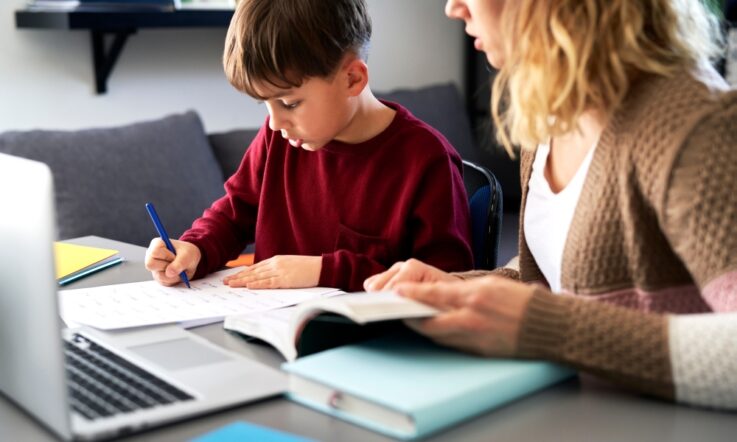Academic motivation is well-established as a critical factor in helping students to be engaged and to succeed at school. Now, recognition of the importance of social-emotional motivation is also growing. In particular, researchers are interested in learning how social-emotional motivation is linked with students’ wellbeing and healthy adjustment in life.
This is what I set out to examine in my newly published study in Social Psychology of Education. I examined prosocial motivation, which is a type of social-emotional motivation related to being considerate towards others. It refers to individuals’ drive or inclination to act in prosocial ways, such as helping someone, sharing, or being kind to others.
Specifically, I examined how students’ social-emotional self-beliefs (that is, perceptions about their social and emotional skills and interactions) predict their prosocial motivation and, in turn, how prosocial motivation is associated with their behavioural and wellbeing outcomes.
The study’s sample comprised 408 high school students in Years 7-12 (and their parents/carers) from Victoria and Queensland. Students completed a survey about their social and emotional development, and parents and carers were also asked to provide their perspectives on their child’s social and emotional development in order to have two different viewpoints.
Types of prosocial motivation
In my study, two forms of prosocial motivation were examined:
- Autonomous prosocial motivation, which involves being motivated to act prosocially because it is enjoyable, or because the consequence of acting in such a way is personally valued (Collie, 2021; Ryan & Deci, 2017). For example, a student helping a peer because they like being helpful, or because they would like the favour returned.
- Controlled prosocial motivation, which involves being motivated to act prosocially to avoid feeling guilty or to avoid punishment. For example, a student helping a peer because otherwise they will feel like a bad person, or because they think they will get in trouble if they don’t help.
In general, we ideally want students to be autonomously motivated because it is aligned with more adaptive outcomes (Collie, 2020). For example, autonomous motivation for schoolwork is linked with greater academic engagement and achievement (Howard et al., 2021). In this study, the aim was to see if autonomous prosocial motivation is linked with positive outcomes too.
Factors impacting prosocial motivation
In the study, it was expected that students with stronger social-emotional self-beliefs would report greater autonomous prosocial motivation and lower controlled prosocial motivation. Two social-emotional self-beliefs featured centrally in the study:
- Social competence refers to students’ sense that they can interact effectively with others by, for example, listening considerately, cooperating effectively, and resolving disagreements constructively.
- Relatedness with teachers involves students’ sense that their teachers care for them.
Alongside the self-belief and motivation factors, the study also looked at behaviour and wellbeing outcomes.
- Prosocial behaviour involves actions that students take to aid others (e.g. helping, sharing). Parents and carers were asked about this outcome.
- Emotional wellbeing refers to students’ experiences of more positive emotions and fewer negative emotions. Students were asked about this outcome.
Autonomous prosocial motivation was expected to be associated with greater prosocial behaviour and emotional wellbeing. In contrast, the reverse was expected for controlled prosocial motivation.
What were the findings?
As expected, students with a stronger self-belief for social competence reported greater autonomous motivation and lower controlled motivation. In addition, students who felt more connected with their teachers reported greater autonomous motivation.
These findings indicate that students who feel more confident about their ability to interact effectively with others and who have stronger interpersonal relationships with teachers at schools, are more likely to be prosocially motivated by reasons of enjoyment, satisfaction, and valuing these things personally.
In terms of links between motivation and the outcomes, students who reported greater autonomous motivation exhibited greater prosocial behaviour (as reported by parents). In contrast, students who had higher controlled motivation exhibited lower prosocial behaviour and reported lower emotional wellbeing.
Together, the findings suggest that social-emotional self-beliefs are important for autonomous prosocial motivation and, in turn, adaptive behaviour and wellbeing.
Implications for teachers and schools
We can conclude from the study’s findings that it’s important to support students’ social-emotional self-beliefs in order to boost autonomous prosocial motivation and the related outcomes.
One way that schools can do this is through effective social and emotional learning programs. For example, research shows that SEL programs can help to boost students’ sense of social-emotional competence and their relatedness with students and teachers (e.g. Metz et al., 2013).
In addition, teachers can incorporate practices within the classroom to support students’ social-emotional self-beliefs, such as:
- providing rationales on why it is important to be considerate to others;
- encouraging students’ involvement in the creation or refinement of rules and norms;
- providing clear goals and expectations for social-emotional interactions in the classroom;
- offering feedback for how students can be considerate in responding to others during group discussions; and,
- showing interest in and dedicating resources and time to students (Collie, 2022; Skinner & Belmont, 1993).
References
Collie, R.J. (2020). The development of social and emotional competence at school: An integrated model. International Journal of Behavioral Development, 44(1), 76-87. https://doi.org/10.1177/0165025419851864
Collie, R.J. (in press, accepted March 2022). Social-emotional need satisfaction, prosocial motivation, and students’ positive behavioral and well-being outcomes. Social Psychology of Education. https://doi.org/10.1007/s11218-022-09691-w
Howard, J.L., Bureau, J., Guay, F., Chong, J.X.Y., & Ryan, R.M. (2021). Student motivation and associated outcomes: A meta-analysis from self-determination theory. Perspectives on Psychological Science, 16(6), 1300-1323. https://doi.org/10.1177/1745691620966789
Metz, S. M., Frank, J. L., Reibel, D., Cantrell, T., Sanders, R., & Broderick, P. C. (2013). The effectiveness of the Learning to BREATHE program on adolescent emotion regulation. Research in Human Development, 10(3), 252–272. https://doi.org/10.1080/15427609.2013.818488
Ryan, R. M., & Deci, E. L. (2017). Self-Determination Theory: Basic Psychological Needs in Motivation, Development, and Wellness. Guilford Press. https://doi.org/10.1521/978.14625/28806
Skinner, E. A., & Belmont, M. J. (1993). Motivation in the classroom: Reciprocal effects of teacher behavior and student engagement across the school year. Journal of Educational Psychology, 85(4), 571–581. https://doi.org/10.1037/0022-0663.85.4.571
Think about the practices mentioned by Dr Rebecca Collie in this article that can be used within the classroom to support students’ social-emotional self-beliefs.
Which practices are you already implementing in your classroom? How could you implement more next term?



